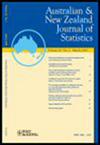逆G-Wishart分布与变分消息传递
IF 0.8
4区 数学
Q3 STATISTICS & PROBABILITY
引用次数: 5
摘要
在因子图上传递消息是为任意大型图形模型编写近似推理算法的强大范例。因子图片段的概念允许代数和计算机代码的划分。我们证明了逆G-Wishart分布族使基本变分消息传递因子图片段能够优雅而简洁地表达。这种片段出现在对协方差矩阵或方差参数进行近似推理的模型中,在当代统计学和机器学习中无处不在。本文章由计算机程序翻译,如有差异,请以英文原文为准。
The Inverse G-Wishart distribution and variational message passing
Message passing on a factor graph is a powerful paradigm for the coding of approximate inference algorithms for arbitrarily large graphical models. The notion of a factor graph fragment allows for compartmentalisation of algebra and computer code. We show that the Inverse G-Wishart family of distributions enables fundamental variational message passing factor graph fragments to be expressed elegantly and succinctly. Such fragments arise in models for which approximate inference concerning covariance matrix or variance parameters is made, and are ubiquitous in contemporary statistics and machine learning.
求助全文
通过发布文献求助,成功后即可免费获取论文全文。
去求助
来源期刊
CiteScore
1.30
自引率
9.10%
发文量
31
审稿时长
>12 weeks
期刊介绍:
The Australian & New Zealand Journal of Statistics is an international journal managed jointly by the Statistical Society of Australia and the New Zealand Statistical Association. Its purpose is to report significant and novel contributions in statistics, ranging across articles on statistical theory, methodology, applications and computing. The journal has a particular focus on statistical techniques that can be readily applied to real-world problems, and on application papers with an Australasian emphasis. Outstanding articles submitted to the journal may be selected as Discussion Papers, to be read at a meeting of either the Statistical Society of Australia or the New Zealand Statistical Association.
The main body of the journal is divided into three sections.
The Theory and Methods Section publishes papers containing original contributions to the theory and methodology of statistics, econometrics and probability, and seeks papers motivated by a real problem and which demonstrate the proposed theory or methodology in that situation. There is a strong preference for papers motivated by, and illustrated with, real data.
The Applications Section publishes papers demonstrating applications of statistical techniques to problems faced by users of statistics in the sciences, government and industry. A particular focus is the application of newly developed statistical methodology to real data and the demonstration of better use of established statistical methodology in an area of application. It seeks to aid teachers of statistics by placing statistical methods in context.
The Statistical Computing Section publishes papers containing new algorithms, code snippets, or software descriptions (for open source software only) which enhance the field through the application of computing. Preference is given to papers featuring publically available code and/or data, and to those motivated by statistical methods for practical problems.

 求助内容:
求助内容: 应助结果提醒方式:
应助结果提醒方式:


